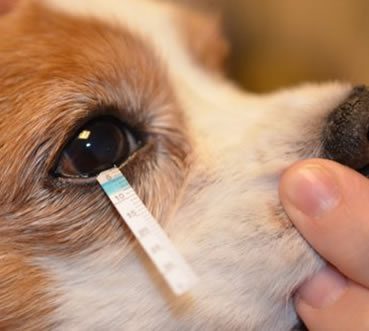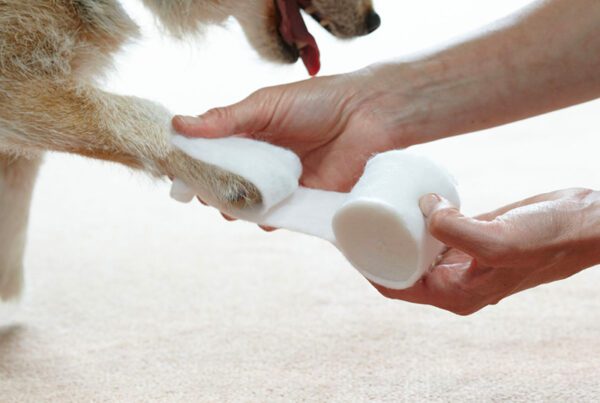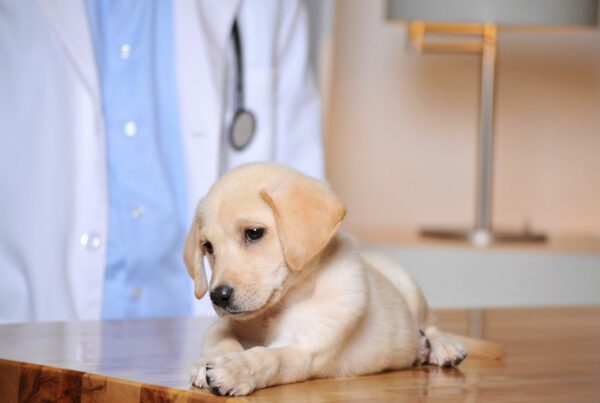Keratoconjunctivitis sicca (KCS) is a relatively common problem seen in dogs, often termed ‘dry eye’. Dry eye occurs due to a reduction in the quality of tear production in your dog’s eye. Tears normally keep your pet’s eye healthy and lubricated. If your pet is not producing enough tears they can quickly develop sore, infected eyes and in severe cases vision can be affected.
What causes dry eye?
The most common cause of dry eye is damage to the cells that produce tears by the dog’s own immune system – this is what we call an immune mediated disease. As a consequence, the tear film usually spread across your dog’s eye when they blink is insufficient, causing the eye to become dry. The problem is often exacerbated by abnormalities with the production of mucin, another important component of the dog’s normal tear film. If left untreated, there may be permanent damage to the eye that can be painful and even lead to blindness.
Dry eye may also be caused by neurological problems affecting nerve supply to the glands producing tears, however this form is less common. Dry eye may also be seen with hypothyroidism, trauma, drug reactions and developmental causes although again these are all far more unusual than the immune-mediated form of the condition.
Although dogs of any age and sex may be affected, certain breeds do seem particularly at risk of developing dry eye, including the:
- West Highland White Terrier
- English Bulldog
- Cocker Spaniel
- King Charles Cavalier Spaniel
- Lhasa Apso
Although possible, dry eye is much rarer in cats.
These cases tend to be due to trauma or Feline Herpesvirus rather than immune-mediated.
What should I look for?
Although the appearance of dry eye can be variable, signs to look for may include:
- Recurrent eye infections / conjunctivitis
- Thick tacky yellow or green eye discharge
- Itchy eyes or rubbing at face
- Sore or painful eyes (closed eyelids / red conjunctiva / squinting)
- Lacklustre appearance to surface of eyes
Treatment
Fortunately treatment is available for dry-eye, but it should be noted that treatment for immune-mediated dry eye is invariably required for life. The earlier the condition is detected however, the better the long-term results of treatment are. Dry eye is usually managed medically with a combination of different medications:
- There is only one medicine currently available to treat the condition, called Ciclosporin, which works by preventing the immune system from attacking the tear-producing cells. This can be applied once to twice daily and may take up to 6 to 8 weeks to gain maximum effect.
- Artificial tears – to lubricate the eye
- Antibiotics – to treat secondary infections
- Steroids – to control inflammation
It is important to recognise that treatment must be lifelong. If left untreated your pet may develop several secondary problems including:
- Recurrent eye infections
- Pain / irritation
- Corneal ulcers
- Blindness
In cases where the loss of tear production is absolute and permanent, medical management isn’t feasible or successful, or where irreversible changes have occurred, surgery may be considered in the form of a specialist surgery known as a parotid duct transposition or even removal of the eye.
Diagnosis
Dry eye can be easily diagnosed in a consultation with your vet. The condition is diagnosed on the basis of clinical signs and a specific test measuring your pet’s tear production known as a Schirmer Tear Test. The test only takes a few minutes and involves a small paper strip being placed behind your pet’s lower eyelid and left in place for one minute. Tears produced will be soaked up by this paper strip and measured using a scale.
Normal tear production will cause the strip to turn blue up to, or above, the fifteen millimetre mark on the strip. Tear production less than this indicates reduced tear production and is highly suggestive of dry eye.
Summary
- Dry eye is a relatively common condition that can be easily managed by owners at home.
- If not detected and treated however, it can cause permanent damage to your pet’s eye and even blindness.
- Early detection produces better long-term results. If you suspect your pet may have dry eye then ask your vet.





